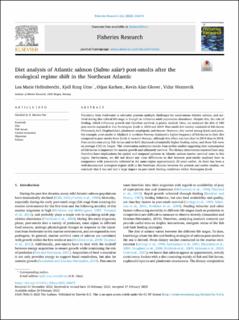| dc.contributor.author | Hellenbrecht, Lea Marie | |
| dc.contributor.author | Utne, Kjell Rong | |
| dc.contributor.author | Karlsen, Ørjan | |
| dc.contributor.author | Glover, Kevin Alan | |
| dc.contributor.author | Wennevik, Vidar | |
| dc.date.accessioned | 2023-10-10T10:22:28Z | |
| dc.date.available | 2023-10-10T10:22:28Z | |
| dc.date.created | 2023-03-07T17:46:49Z | |
| dc.date.issued | 2023 | |
| dc.identifier.citation | Fisheries Research. 2023, 262 . | |
| dc.identifier.issn | 0165-7836 | |
| dc.identifier.uri | https://hdl.handle.net/11250/3095433 | |
| dc.description.abstract | Transition from freshwater to saltwater presents multiple challenges for anadromous Atlantic salmon, and survival during this critical life-stage is thought to influence adult population abundance. Despite this, the role of feeding, which influences growth and therefore survival, is poorly studied. Here, we analyzed the diet of 580 post-smolts captured in four Norwegian fjords in 2018 and 2019. Post-smolt diet mainly consisted of fish larvae (Teleostei), krill (Euphasiidae), planktonic amphipods, and insects. However, diet varied among fjords and years. For example, post-smolts in Altafjord in northern Norway displayed a higher frequency of fish larvae in their diet compared to post-smolts from fjords in western Norway, although this effect was less clear in 2019 than in 2018. Post-smolts consuming fish larvae and/or krill displayed substantially higher feeding ratios, and these fish were on average 0.52 cm longer. This observation underpins results from earlier studies suggesting that consumption of fish larvae is important for marine growth and ultimately survival. The dietary observations reported here may therefore have implications for spatial and temporal patterns in Atlantic salmon marine survival rates in this region. Furthermore, we did not detect any clear differences in diet between post-smolts analyzed here in comparison with post-smolts collected in the same region approximately 20 years earlier. As there has been a well-documented ecological regime shift in the Northeast Atlantic between the present and earlier studies, we conclude that it has not had a large impact on post-smolt feeding conditions within Norwegian fjords. Diet Fish larvae Coastal ecosystem Migration Estuary | |
| dc.language.iso | eng | |
| dc.title | Diet analysis of Atlantic salmon (Salmo salar) post-smolts after the ecological regime shift in the Northeast Atlantic | |
| dc.title.alternative | Diet analysis of Atlantic salmon (Salmo salar) post-smolts after the ecological regime shift in the Northeast Atlantic | |
| dc.type | Peer reviewed | |
| dc.type | Journal article | |
| dc.description.version | publishedVersion | |
| dc.subject.nsi | VDP::Zoologiske og botaniske fag: 480 | |
| dc.subject.nsi | VDP::Zoology and botany: 480 | |
| dc.source.pagenumber | 0 | |
| dc.source.volume | 262 | |
| dc.source.journal | Fisheries Research | |
| dc.identifier.doi | 10.1016/j.fishres.2023.106672 | |
| dc.identifier.cristin | 2132085 | |
| dc.relation.project | Norges forskningsråd: 280308 | |
| cristin.ispublished | true | |
| cristin.fulltext | original | |
| cristin.qualitycode | 1 | |
